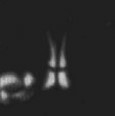Sphenolithus cometa
Set number: 924
-
1
-
2
10µm
Sphenolithus cometa de Kaenel & Villa, 1996
Medium to large size (5.0-9.0µm) species of Sphenolithus Deflandre in Grassé, 1952 having an elongated cylindrical proximal cycle, reduced lateral cycle and gently diverging long apical cycle.
The multi-spine apical cycle resembles a comet and has three or more long segments. In the side view, all the segments of the apical spine display maximum birefringence at 45°, but only two outer segments display maximum birefringent at 0°.
The lateral cycle is more distinct at 45°, where the elongated proximal cycle is extinct (parallel extinction).
Inner ends of the proximal cycle segments joined at least half of their length along the longitudinal axis but not joined nearer the proximal end, thus forming a shallow conical proximal cavity. The segments may be flare outward at the proximal end.
Sphenolithus cometa differs from Sphenolithus capricornutus Bukry & Percival, 1971 and Sphenolithus multispinatus Maiorano & Monechi, 1997 by having always elongated proximal and apical cycles with minor divergence.
Bukry, D. & Percival, S. F. 1971. New Tertiary calcareous nannofossils. Tulane Studies in Geology and Paleontology 8: 123-146.
Deflandre, G. 1952. Classe des Coccolithophoridés. (Coccolithophoridae. Lohmann, 1902). In: Grassé, P. P. (Ed.), Traité de Zoologie. Masson, Paris. 439-470.
de Kaenel, E. & Villa, G. 1996. Oligocene-Miocene calcareous nannofossil biostratigraphy and paleoeecology from the Iberian Abyssal Plain. Proceedings of the Ocean Drilling Program, Scientific Results 149: 79-145.
Maiorano, P., Monechi, S., 1997. New Early Miocene species of Sphenolithus Deflandre, 1952 from the North Atlantic Ocean. Journal of Nannoplankton Research 19(2), 103-107.


